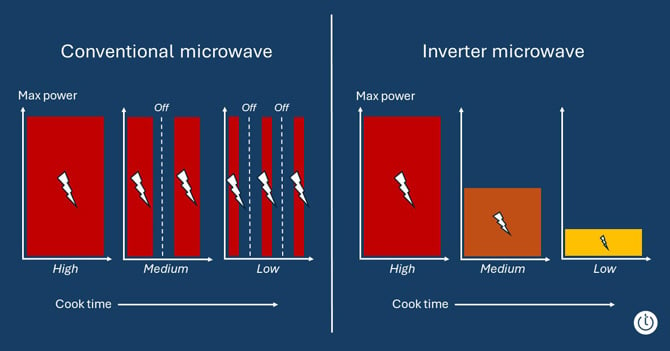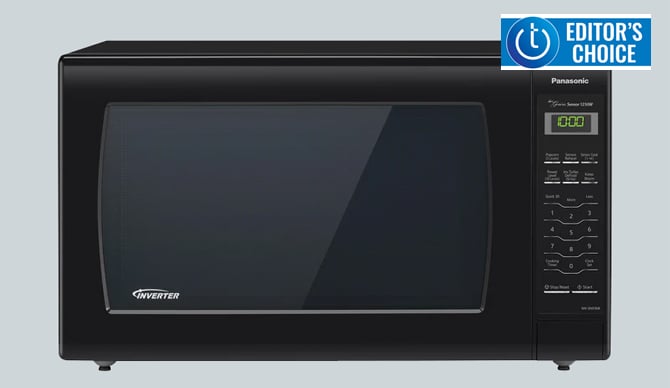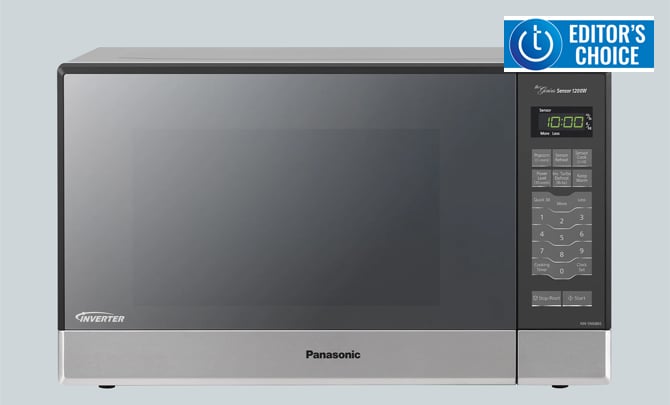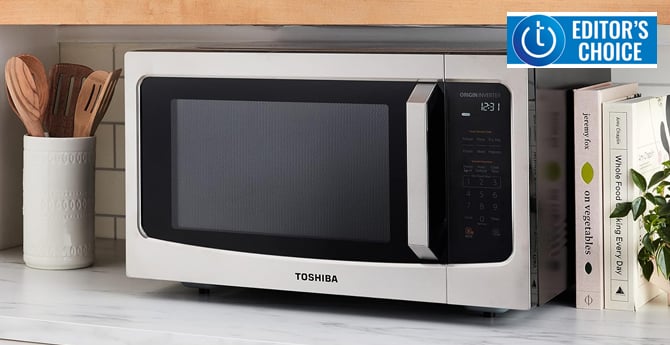We may earn commissions when you buy from links on our site. Why you can trust us.
Microwave Ovens with Inverter Technology Really Cook
Updated 3/3/2024 with improved chart, market information, and recommended models.
If you’re like most consumers, your microwave oven serves two main duties: boiling water and reheating leftovers. But wouldn’t it be great if rather than just taking up a chunk of space in your kitchen, you could actually rely on your microwave for cooking meals?
Cooking food successfully in a microwave is challenging because the magnetron, the element that cooks the food in most microwaves, can only deliver full power. Even when set to “50% power”, the microwave oven is going through cycles of delivering 100% power, followed by a period of no power.
Imagine if your regular oven worked this way. Instead of cooking a roast at 350 degrees, you’d cook it at 700 degrees for ten minutes, then take it out for ten minutes, and repeat over and over again until the meat is cooked. Good luck with that!
The microwave inverter solution
Originally developed by Panasonic, there are now multiple brands on the market offering “inverter” technology, which aims to solve this problem. The inverter modulates the level of energy being transmitted by the oven to achieve a consistent level. So when you set 50% power, for example, you get a steady stream of 50% power for the entire cooking time. The result is more evenly cooked food, defrosting without cooked edges, and even the ability to keep foods warm until mealtime.

I spent weeks testing Panasonic inverter microwave ovens. Using recipes from Panasonic, including some produced by the prestigious Culinary Institute of America specifically for inverter microwaves, I made hollandaise sauce, fruit crisp, corn chowder, barbecued pulled pork, and other fun dishes.
What I found was that the microwave inverter performed surprisingly well for dishes that required slow cooking in moist environments, such as the hollandaise sauce (which can be tricky to do on the stovetop) and pulled pork. Corn chowder worked fine as well, though it would have been just as easy on the stovetop and we didn’t like moving large bowls of boiling liquid in and out of the oven. Perhaps not surprisingly, the fruit crisp was a flop, with a soggy, raw-tasting topping and overcooked fruit underneath. However, this could be fixed by finishing it in your oven or air fryer.
Final take on inverter technology
Based on my experiences, I could easily see using an inverter microwave in addition to my standard cooktop and range, especially during busy holiday times when I am trying to cook many dishes at once, while also keeping everything warm until serving time. It is a fast and clean way to steam vegetables, melt chocolate, braise meats, or do any one of a number of occasional kitchen tasks that involve steady cooking and do not require browning.
Recommended models
If you are purchasing a microwave, I strongly recommend considering an inverter model. Various options are offered by Breville, Cuisinart, LG, Panasonic, Sharp, and Toshiba, among others. As the originator of inverter technology, Panasonic has been in the game for decades. They offer models to fit pretty much every space and budget. However, you’ll get a little more bang for your buck with Toshiba.

Panasonic NN-SN936B: Best full-size inverter microwave
The Panasonic NN-SN936B excels in even cooking, user-friendliness, and power. With 1250W of power and a sizeable 2.2 cubic foot capacity, it’s perfect for families. Turbo Defrost and the Genius Sensor help to heat quickly, while avoiding overcooking. And 14 one-touch cooking options for popular items like popcorn, potatoes, and more, keep operation simple.
While I haven’t tested this model directly, it has the exact same inverter technology and features as the discontinued models I reviewed previously.
Specifications
- Capacity: 2.2 cubic feet
- Wattage: 1250 watts
- Turntable: 16.5 inches
- Dimensions: 23⅞" W x 14" H x 19 7/16" D
- Finish: Black or White
Panasonic NN-SN686S: Best compact inverter microwave
The Panasonic NN-SN686S is an excellent choice for those seeking a reliable, mid-sized microwave featuring the precision of Inverter Technology. If you have limited counter space or don't typically cook for larger groups, this model offers all the key benefits of the NN-SN936B in a more compact package.
Specifications
- Capacity: 1.2 cubic feet
- Wattage: 1200 watts
- Turntable: 13.4 inches
- Dimensions: 20.7" W x 12.2" H x 15.8" D
- Finish: Stainless Steel
Toshiba ML-EM45PIT(BS): Best value inverter microwave
The Toshiba ML-EM45PIT(BS) is an excellent choice if you're looking for maximum bang for your buck. It offers a larger capacity (1.6 cubic feet) and slightly more power (1250 watts) compared to the Panasonic NN-SN686, while maintaining a very similar price point. A Smart Sensor adjusts power levels and cooking times automatically based on the food's moisture (similar to Panasonic's Genius Sensor), while 6 preset auto cook options cover the basics.
Specifications
- Capacity: 1.6 cubic feet
- Wattage: 1250 watts
- Turntable: 13.6 inches
- Dimensions: 21.8" W x 13" H x 19.2" D
- Finish: Black Stainless Steel
Discussion 
Do you happen to know anything about differences in the Model Nos of Panasonic’s Microwave Ovens? I cannot get a substantive response from Panasonic support.
Our NN-SN651W (Inverter) died after several years of use. We liked it, except for its size. We found a larger model - NN-SN975S - at Sam’s Club, but the Panasonic website only lists an NN-SD975S model, nothing about the NN-SN975S.
From photos, I can see that the NN-SD975S has a knob, but the NN-SN975S does not. I can’t tell what that means or whether there are any other differences between these two. I’ve sent emails and made phone calls, but I cannot get anyone at Panasonic who will tell me the differences between these two models.
Do you know or have any suggestions?
Thanks.
All of the Panasonic 2.2CF inverter microwaves have the same basic cooking technology as far as wattage (1250W) and the inverter. However, the NN-SD975S also adds Panasonic’s relatively new “cyclonic wave” technology, which aims to more evenly distribute the waves throughout the interior of the oven. We haven’t tested cyclonic vs non-cyclonic to determine what impact, if any, that makes.
As you noted, the control methods are different between the two models, but they appear to offer largely the same cooking features as far as presets, etc. So it really comes down to a matter of preference.
WE have a Panasonic microwave oven with Inverter technology, but have noticed that it interferes with WIFI in our home. It stops the signal to our TV and also to our cell phones. Would this be a malfunction in our oven?
My husband bought this microwave oven in July this year just as our 10 year old regular Panasonic 750 W was packing up. Due to space constraint we opted to purchase a tabletop microwave oven over a cooker - oven. I absolutely love using this little wonder. Pre heating is a breeze and cook time is drastically reduced. I never fail to be amazed by its energy efficiency. It’s particularly impressive when it comes to cooking using the Combi feature.
Seems too much like an advertisement.
To be believable it needs to have the bad points as well.. there are always some
This is not an advertisement, sometimes we just really like a particular technology implementation. If you read our article on the Best Microwave Oven I do discuss some of the negatives of the Panasonic ovens themselves, notably with longevity issues on the inverter. Though, microwave reliability is a problem across the board with all brands.
I too am a fan of nation Panasonic inverter technology..
But if a review contains no bad points.. I distrust it.
Kindly assist me with a capable firm that can repair my Microwavwe Oven Panasonic Model No:NN-C2003S.
Regards
Owen,Based in Potchefstroom,NW Province
065 994 1762
What, if anything, is the difference between “inverter” & “cyclonic wave inverter”. If the latter is better, is it in all Panasonic inverter microwaves and in no other brands with inverters e.g. L G.?
The inverter is a component of the microwave that reduces the power from the magnetron, enabling you to cook food more slowly. Both the standard Panasonic microwaves and the “cyclonic” use the same inverter technology. The “Cyclonic” feature is a means of distributing the waves more evenly inside the microwave, which Panasonic claims will result in more even cooking. So, Inverter reduces wave power, cyclonic distributes waves more evenly. I haven’t tested the cyclonic feature against a non-cyclonic oven, though I would expect benefits to be limited. Other brands may have a similar function to cyclonic, but call it something different than what Panasonic does.
Unlike Mr. Kirchner, I use the microwave for EVERYTHING. I do have a stove with an oven which I use every couple of months. My Panasonic inverter MW is a nightmare to use. You have to reduce the power level for everything except heating coffee and you have to reduce it more for ‘dense foods’. No one can explain what a ‘dense food’ is. I offered to send Panasonic a list of the microwave meals I normally eat and have them tell me whether they were dense or not and they told me they wouldn’t be able to tel!!! The MW has been getting weaker lately and when I called Panasonic they suggested I drive it over to a repair facility in a nearby state!!!! Unbelievable. I intend to sell this one on Craig’s list for a dollar with appropriate warnings.
With “dense” foods, the microwaves will not penetrate as far, so you want to use lower power to allow time for the heat to carry into the interior of your food without overcooking the outside. Dense foods will typically be ones that contain a lot of water or are saucy (think dense lasagna vs less-dense broccoli). If you find this too complicated, you may want to just use the Panasonic’s autocook modes.
Any microwave from any brand will have these same issues. The difference is that Panasonic allows you to control the power of the microwaves in a much more precise manner. And if you are coming from an old, low-wattage microwave (maybe around 800 Watts) to a new 1250 Watt Panasonic, you will definitely see faster cooking.
You work for Panasonic, don’t you. The G.E. microwave I had before this one was better! It matched the instructions provided on the meals I prepared. A big plus! As I have said before, This panasonic cooks unevenly and is getting weaker. Fortunately, it is likely to break altogether soon and I will be able to defend buying another - not inverter - G.E. microwave.
Great info. Funny but was looking for a converter chart for numbers 1-10 to approximate oven temps. First use on a side dish prepackaged food—box recipe says 1000 watts for 5 min. Found an online conversion chart says 1200watts for 4 min 10secs. Result was a bit of overflow on the glass dish. Upgraded model so I hope it might be door latch- my last microwave lasted 2 1/2 months!! First it arced, next day it blew a microwave safe dish to smithereens !! Returned with no no problems. All my older microwaves were Panasonic soon just went back to them!
The article is spot on in stating that power levels, by themselves, are almost worthless. A huge help would be if microwave recipes state the power wattage being used. That would give the consumer some idea of any correction that needs to be made.
A typical direction of “Microwave on high for 3 minutes” is meaningless. What is so hard for the product to include the text such as “at 800 watts?” There is room to add the text to the packaging.
After many years of use, my old Sharp model has died. That one allowed selecting a sequence of stages. For example full power for 90 seconds followed by 20% power for three minutes would bring oatmeal to a boil and the cook it for three minutes without overflowing the bowl. I can not find that same sort of “steps” sequence being specifically noted on any but commercial models. Is that chaining together of steps available on most of the current middle to upper level homeowner models, say $200 -$300 (US)?
The higher-end Panasonic models, such as our pick for the best microwave oven, have “Stage” cooking that will do what you’re describing.
Hi I’m trying to recover a Panasonic inverter the genius oven model number NN-T783SF 1200watt
Can someone please indicate you wear the capacitors are on this particular model from what I can see there doesn’t seem to be any capacitor there at all and I know that they are not hard to spot.
Any help gratefully accepted.
I have now been using Panasonic microwaves for almost 20 years. Started when their (at that time) newly PATENTED Inverter technology caught my attention, as I was working with 10kW (and larger) semiconductors used as invertors in some advanced welding equipment. I have from then until now wondered why they seem to be the only brand of touch pad controlled microwave that does not use the “touch power button, touch number for power” scheme of programming. I say this because no one else in family / friends have a Panasonic and all are baffled how to set power on it.
As to the inverter used to provide “variable output power from the magnetron” it in fact DOES NOT. In a “normal” microwave the magnetron is pulsed on and off at various rates so that over a 1 MINUTE time the AVERAGE power is reduced. This is because a magnetron is operated by a high DC voltage that causes pulses or “oscillations” of electrons at extreme high frequencies (gHz / “microwave”), determined by the exact voltage and mechanical construction of the magnets around the central vacuum tube. It can only be on or off - similar to a fluorescent light. All the invertor does is take advantage of the extreme speed and WATTAGE that has become available in semiconductors. Instead of a mechanical relay switching the power to the HV transformer on or off every few seconds, the HV power supply is in continuous operation but applied through semiconductors in a “pulsed” fashion at something like a 100kHz rate. So now by eliminating a variable percentage of the “pulses” you get the appearance of variable power because the averaging is being done across a 1 millisecond duration rather than a 1 minute duration. So at 10% power a non-inverter microwave’s magnetron is probably on for 3 seconds, then off for 27 - not much use, eh? The invertor microwave at 10% power is also off the same relative time, but does it by 3 milliseconds on then 27 milliseconds off or similar, repeating this high speed cycle at a hundred times a second or similar. Though your food is still being blasted by full power, it is in extremely short pulses and the energy averaging works much better, allowing heat to propagate into the food rather than just heating the surface.
Second, I don’t understand the frequent comments through this thread about recommended oven wattage not being listed for foods. “Microwave meals” and recipes / heating instructions on almost everything I have dealt with for 20 years have almost invariably finished with “times based on a #### Watt oven” - usually 1000 Watts these days, 15 years ago was more common to see 700 or 800. I think too many people don’t read the full instruction, and also some use an * to try to get you to look for “fine print” at the bottom.
Third - you cannot actually “steam cook” anything in a microwave. While it is true that microwave are most effective on water, it is also true that you can’t boil water in a microwave - watery mixtures, (like oatmeal) possibly, but water - no. It is physics stopping you and you aren’t going to change the laws of physics. When you put something in a stovetop steamer, it receives all of its heat from the water vapor at approx 210 degrees, and may absorb some of the water as well. I you try that in the microwave you get far less steam, and A LOT of direct heating of the food from the microwaves themselves. So if you are trying to make chinese steamed dumplings the centers may still be cold while the outside is hot and wet on top but nearly dry on the bottom facing the dish.
Because the watts per second can be reduced I have found I not only don’t have to set butter out to soften an hour before starting to make cookie dough, I can take it straight from the freezer, thaw and soften it without melting any of it. And crispy bacon without burning it? A couple minutes at 8,9, or 10 to “cook” it, them a few minutes at 3 to dry it out - makes it real crisp and you have to overshoot the low power time by several minutes before it becomes unusable for crumbled bacon.
A few manufacturers do specify the wattage on which their cooking times are based. Regrettably, a vast majority of manufacturers still do not specify the wattage—so a consumer has to guess.
The usual “weasel words” are always included, along the lines of “Oven cooking varies, so you may have to adjust your times.”
Giving the wattage used, at least, gives the consumer a fighting chance of getting it right the first time. Text is cheap, put it on the package!
Our 22 year old Kenmore Elite microwave with UltraWave finally died and I replaced it with a Frigidaire Gallery from Lowes because it had similar features that we were used to.
I just assumed (wrongly) that here in the New Millennium all microwaves would have inverter technology.
Our new Frigidaire is banging on and off like the $20 Goodwill micro we had on the counter in college. Boiling over the oatmeal and leaving dinner with frozen spots in it.
Are there any new Over-The-Range microwaves with inverter technology?
THANKS

















From pawan on August 02, 2019 :: 9:06 pm
I see, most of the microwaves by Panasonic are based on its inverter technology, which is good for the efficient cooking power.
Reply